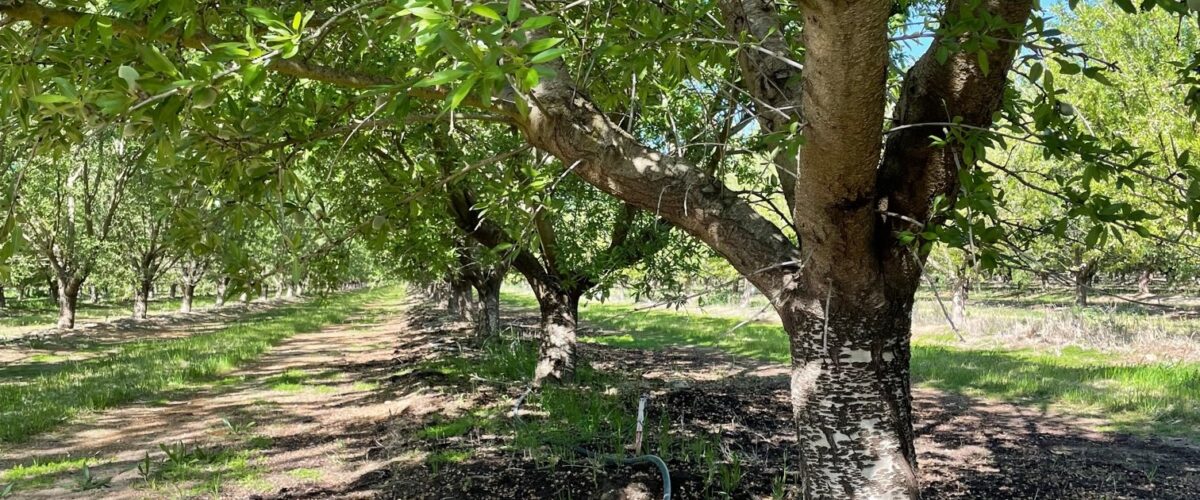Aiming to capture real-world data, researchers on the DSWR project are working on both research farms as well as commercial farms.
And the studies are not only happening on dairies. Researchers at the University of California Davis are conducting trials at a commercial almond orchard, Due Farms.
Adolfo Coyotl, a graduate student at the university, is working on the project there alongside owner Matt Due.
What is your research focus on the farm?
My research focus is broadly on biogeochemical and soil health implications of dairy manure compost surface application in perennial systems such as California almond orchards. My preliminary results show that net soil nitrous oxide emissions are reduced by the interaction between dairy manure compost and fertigation compared to conventional fertigation application only. This leads me to my main research question: How does carbon, specifically dairy manure compost-derived carbon, in tandem with fertigation, affect the soil microbial community’s processing of nitrogen, and its resulting control on nitrous oxide emissions? To answer this question I seek to:
- Assess the interactive effects of surface application of dairy manure compost and fertigation on soil health/physicochemical properties in almond orchard soils.
- Explore the mechanistic processes involved in the reduction of net nitrous oxide emissions in compost plus fertigation treatments relative to fertigation only.
- Determine the potential of natural differences in nitrous oxide molecules for predicting which microbial nitrogen processes are primarily responsible for observed reduction in nitrous oxide emissions.
What is the significance of doing this research on a commercial farm?
I believe that the primary significance of doing this research on a commercial farm is scalability and reproducibility. By demonstrating that soil health management practices can reduce greenhouse gas emissions without requiring a reduction in nitrogen inputs, thereby maintaining yields, on a commercial farm provides a strong basis for broader adoption by other producers. Additional co-benefits such as decreased soil bulk density, improved soil water storage and faster-growing trees can grant farmers the confidence to implement some degree of soil health practices into their management plan.
In California, there is significant geographic overlap between the highest almond producing counties as well as the largest dairy operations. A tight nutrient economy can arise from almond waste products, e.g., hulls and shells, being used as supplemental dairy feed, from which processed manure can be added back to the almond orchards. There is great potential in collaboration between the dairy industry and commercial almond orchards to achieve economic and environmental goals.
Describe your working relationship with Matt and keys to success.
Working with Matt throughout the DSWR project has been a pleasure. He was gracious enough to allow us to establish a no input control (no compost added, no fertigation applied) on 120 of his almond trees to create a true baseline from which we can compare the effects of our various treatments. His willingness to accept a reduction in yield from those trees showcases his commitment to science-based data production. Matt is also quite agreeable to us working on his orchard for hours on end, even offering us his ATV and Kubota to help us move heavy equipment.
Open communication is the key to the success of the project. We keep Matt in the loop to our various activities and he in turn will let us know what management practice is being executed to help us better schedule our work. For example, Matt will let us know when he has received the liquid fertilizer and is flexible enough to allow us to schedule the exact timing of injection, fertigation and irrigation of the almonds to ensure a complete capture of greenhouse gas dynamics.
What are some things you have learned from working with Matt?
Matt always dispenses interesting knowledge whenever I encounter him in the field. He has taught me about the “green almond” and the “jelly almond,” both are edible variants of almonds before they reach the fully mature nut we are most familiar with, munching on them together as I come to do field work. He has told me stories of how his family had settled in the area in the late 1800s and established themselves with cattle ranching, thus explaining how one of the nearby roads got its name, Due Road. He also told me how the colloquial pronunciation of “amond” became so due to the letter “L” being shaken off during harvest.
But, most importantly, I have learned about the hard work and decision-making involved in producing the almond that we love to snack on.
